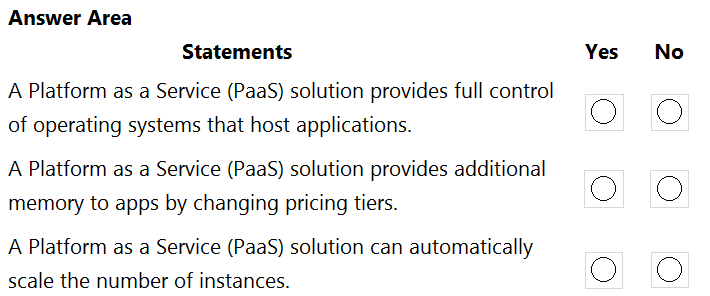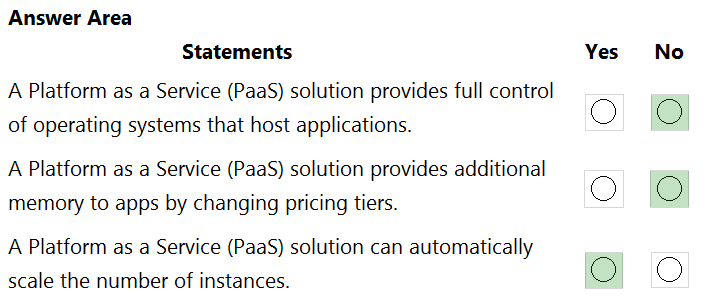HOTSPOT -
For each of the following statements, select Yes if the statement is true. Otherwise, select No.
NOTE: Each correct selection is worth one point.
Hot Area:

HOTSPOT -
For each of the following statements, select Yes if the statement is true. Otherwise, select No.
NOTE: Each correct selection is worth one point.
Hot Area:


Why can't the people who put these tests together get the RIGHT answers after all we are paying to get results....
N, N, Y. On the second and the most discussed question: In Azure, increasing the memory allocated to a Platform as a Service (PaaS) solution, such as an Azure App Service, is typically not achieved by changing the pricing tier. Pricing tiers for PaaS services like Azure App Service primarily affect the CPU, storage, and other resource allocations, but not the memory. To adjust the memory allocated to an Azure PaaS service, you typically need to choose a different service plan or instance size within the same pricing tier. Azure App Service plans, for example, come in various sizes, each with a specific combination of CPU, memory, and other resources. By selecting a different service plan or instance size, you can increase or decrease the memory available to your application. So, while changing the pricing tier can affect the overall performance and resource allocation for a PaaS solution, including CPU and storage, adjusting the memory allocation typically involves selecting the right App Service Plan or instance size within the chosen tier.
no no yes. second question says apps not web apps. Its tricky question
Udemy exam has the 2nd question marked as yes
No YES YES
From MS: "After you create a General Purpose or Memory Optimized server, the number of vCores, hardware generation, and pricing tier can be changed up or down within seconds." The solution is N, Y, Y for me
Check out question #64, same question and they have corrected the answer to NYY
The answer is No,No,Yes. Read the question again, it is never mentioned that the service scales up.
Never seen a bigger waste of misinformation than this piece of s**t testing platforms ought to be SUED for incompetence
NNY because for NYY the text should be "can provide additional memory" not "provides additional memory" - this is a difference!
"provides additional memory to apps by changing pricing tiers", must read the whole sentence
NYY - confirmed with chatgpt
I found the answer YES to second one, here is the link https://azure.microsoft.com/en-us/pricing/details/app-service/windows/
NYY in my understanding
It should be No,Yes,Yes as per sequence.
NO YES YES
Answer is No | Yes | Yes because when you'll select App service plan, you'll see that Memory changes from one tier to another. Different GBs of memory is allocated. So "A Platform as a Service (PaaS) solution that hosts web apps in Azure can be provided with additional memory by changing the pricing tier." is TRUE!!
We have same question (with little modification) wherein they have mentioned Yes for "A Platform as a Service (PaaS) solution that hosts web apps in Azure can be provided with additional memory by changing the pricing tier." Just came back from that question to this question to tell you guys about the solution.
Answer here is correct. No, No, Yes Box 2: Its mentioned as PaaS and not Azure App Service :)
Yes, and any app services-related PaaS out there offers the ability to increase memory / change tier :) Therefore No, Yes, Yes
You literally have the EXACT same question with a different answer. C'mon man! this doesn't make any sense. Please correct it
It's No, Yes, Yes
No YEs YEs
The confusion in this question is that it doesn't clarify who is providing the service.
Question : What does “provides” mean? “Giving the option of increasing”? Or “Increases”? Cause you need to explicitly ask for an increase when doing a price tier change. https://docs.microsoft.com/en-us/azure/azure-sql/database/single-database-scale So if by “provides” the actual meaning is “increases” then indeed NO changing tiers doesn’t change the amount memory UNLESS you explicitly request it... All in all I think that is a bit of a trick question meant to test if people know that they must explicitly request an increase when changing tiers.
What is the first question relating to? Who responsible for OS ?
vendor
i guess it should be NYY in BOX 2 and BOX 3 we are talking about Vertically Scale and Horizontally Scale. Both are supported by a PaaS solution
option 2 to be yes
should be NO YES YES
Answer is NYY When you create an App Service plan in a certain region (for example, West Europe), a set of compute resources is created for that plan in that region. Whatever apps you put into this App Service plan run on these compute resources as defined by your App Service plan. Each App Service plan defines: Operating System (Windows, Linux) Region (West US, East US, etc.) Number of VM instances Size of VM instances (Small, Medium, Large) Pricing tier (Free, Shared, Basic, Standard, Premium, PremiumV2, PremiumV3, Isolated, IsolatedV2) https://azure.microsoft.com/en-us/pricing/details/app-service/windows/
Should be NYY.
Answers are NO, YES, YES
I agree. To achieve performance efficiency, consider how your application design scales and implement PaaS offerings that have built-in scaling operations. Two main ways an application can scale include vertical scaling and horizontal scaling. Vertical scaling (scaling up) increases the capacity of a resource, for example, by using a larger virtual machine (VM) size. Horizontal scaling (scaling out) adds new instances of a resource, such as VMs or database replicas. See - https://learn.microsoft.com/en-us/azure/architecture/framework/scalability/design-scale
NO YES YES Azure business modal is based up tiers.
Answer from "Discover" According to the current web page context, changing the pricing tier of an App Service plan that your app belongs to can provide more CPU, memory, disk space and extra features like dedicated virtual machines (VMs), custom domains and certificates, staging slots, autoscaling and more. You can scale up by changing the pricing tier of the App Service plan that your app belongs to.
B is wrong. that should be Yes
Changing pricing tier can increase or decrease memory, it should be NYY
Box 2 - Yes: You scale up by changing the pricing tier of the App Service plan that your app belongs to.
I saw another question where it 'states' that the answer is: no-yes-yes
N-Y-Y PaaS specification may change if the pricing tier had changed.
I think the given answer is correct. Scaling up or down was not mentioned in box 2
The Ans should be - N Y Y
No Yes Yes
no , yes, yes
The answer on Question 31 contradicts what is here for the second question.
Azure App Service plan overview https://docs.microsoft.com/en-us/azure/app-service/overview-hosting-plans
in the first question it was mentioned as web apps, here it is mentioned as only apps
answer: No , Yes, Yes
As per documentation - Ans should be No, Yes, Yes,
Think the answer should be N,N,Y same answer as MCLC2021
Correct Answer is N Y Y
I agree
Answer should be NO / YES /YES
Box 1 - No Box 2 - Yes Box 3 - Yes
No Yes Yes
1) Paas doesnt support OS related controls to host the applications. 2) Scale up: Get more CPU, memory, disk space, and extra features like dedicated virtual machines (VMs), custom domains and certificates, staging slots, autoscaling, and more. You scale up by changing the pricing tier of the App Service plan that your app belongs to. 3) Scale out: Increase the number of VM instances that run your app. You can scale out to as many as 30 instances, depending on your pricing tier. App Service Environments in Isolated tier further increases your scale-out count to 100 instances. For more information about scaling out, see Scale instance count manually or automatically. There, you find out how to use autoscaling, which is to scale instance count automatically based on predefined rules and schedules. https://docs.microsoft.com/en-us/azure/app-service/manage-scale-up
correct answer is: NO NO YES
i think the key is PaaS solution and not web solution. because that not in all the PaaS solution you have this option.
The naswer is CORRECT. If you have the third saying YES, why the second is ÝES as well? Pricing based-tier will never give you more resource, but depending on the plan you'll have auto scale and done.
from MS: "The new PremiumV3 pricing tier guarantees machines with faster processors (minimum 195 ACU per virtual CPU), SSD storage, and quadruple memory-to-core ratio compared to Standard tier. PremiumV3 also supports higher scale via increased instance count while still providing all the advanced capabilities found in Standard tier. " https://learn.microsoft.com/en-us/azure/app-service/overview-hosting-plans
It should be N, N, Y
NO, YES, YES
NYY is the correct answer
I too felt like NO YES YES...
https://azure.microsoft.com/en-us/pricing/details/app-service/windows/ pricing on App service - PaaS
In my opinion, The answer should Yes, Yes, Yes Lets talk about question 1: Paas provides full control of OS that host application , Yes or No? Answer : Yes, Azure provides various PaaS offerings, such as Azure App Service and Azure Functions, where you can choose the OS for your application. When configuring your PaaS environment, you can select the desired OS from the available options provided by the platform. This allows you to customize the runtime environment for your application based on your specific requirements. Rest two answers are Y, Y.
1: PaaS provides full control of OS that host *operating system*, Yes or No? Answer: No
I think the correct answer is N,N,Y because you can change the pricing tier as the second question mention, but is not specifying increasing thge Price tier, so if you can decrease the price tier in an specific Tier the memory decrease too
The answer is NYY. CoPilot: PaaS solution typically does not provide full control over the underlying operating system that hosts applications., Yes, in many PaaS offerings, changing pricing tiers can provide additional memory and other resources to your applications., A key feature of many PaaS solutions is auto-scaling, which automatically adjusts the number of instances based on demand.
NYY Here are the correct answers for the statements based on the characteristics of a Platform as a Service (PaaS) solution: A Platform as a Service (PaaS) solution provides full control of operating systems that host applications. Answer: No PaaS abstracts the underlying infrastructure, including the operating system, so users do not have full control over it. A Platform as a Service (PaaS) solution provides additional memory to apps by changing pricing tiers. Answer: Yes PaaS solutions often allow scaling resources like memory and compute power by upgrading to higher pricing tiers. A Platform as a Service (PaaS) solution can automatically scale the number of instances. Answer: Yes PaaS solutions typically support automatic scaling to handle varying workloads by increasing or decreasing the number of instances.
1️⃣ A Platform as a Service (PaaS) solution provides full control of operating systems that host applications. ❌ No – PaaS abstracts the underlying OS, so developers do not have full control over it. 2️⃣ A Platform as a Service (PaaS) solution provides additional memory to apps by changing pricing tiers. ✅ Yes – PaaS solutions allow scaling resources like memory and CPU by adjusting pricing tiers. 3️⃣ A Platform as a Service (PaaS) solution can automatically scale the number of instances. ✅ Yes – Many PaaS solutions support auto-scaling based on demand.
No, Yes, Yes